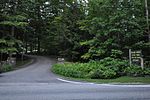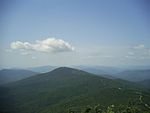Ottauquechee River

The Ottauquechee River (pronounced AWT-ah-KWEE-chee) is a 41.4-mile-long (66.6 km) river in eastern Vermont in the United States. It is a tributary of the Connecticut River, which flows to Long Island Sound. The Ottauquechee rises in the Green Mountains in eastern Rutland County in the town of Killington, and flows generally eastwardly into Windsor County, where it passes through or along the boundaries of the towns of Bridgewater, Woodstock, Pomfret, Hartford and Hartland; and the villages of Woodstock and Quechee. It joins the Connecticut River in the town of Hartland, about 4 miles (6 km) south-southwest of White River Junction.A headwaters tributary known as the North Branch Ottauquechee River flows southeastwardly through the towns of Killington and Bridgewater.Quechee State Park is located along the river near the village of Quechee. Near the river's mouth the U.S. Army Corps of Engineers' North Hartland Dam impounds the river to form North Hartland Lake.Near the state park, the river flows through the 165-foot-deep (50 m) Quechee Gorge. The U.S. Rt. 4 bridge crosses over the gorge and provides good viewing down into its depths.[1] In late August 2011, Hurricane Irene swept through the Ottauquechee River watershed, raising the water level in the river to far beyond its normal height. Houses and towns along the river were devastated.
Excerpt from the Wikipedia article Ottauquechee River (License: CC BY-SA 3.0, Authors, Images).Ottauquechee River
Spring Hill Road,
Geographical coordinates (GPS) Address Nearby Places Show on map
Geographical coordinates (GPS)
| Latitude | Longitude |
|---|---|
| N 43.6651023 ° | E -72.7811448 ° |
Address
Spring Hill Road
Spring Hill Road
05751
Vermont, United States
Open on Google Maps







